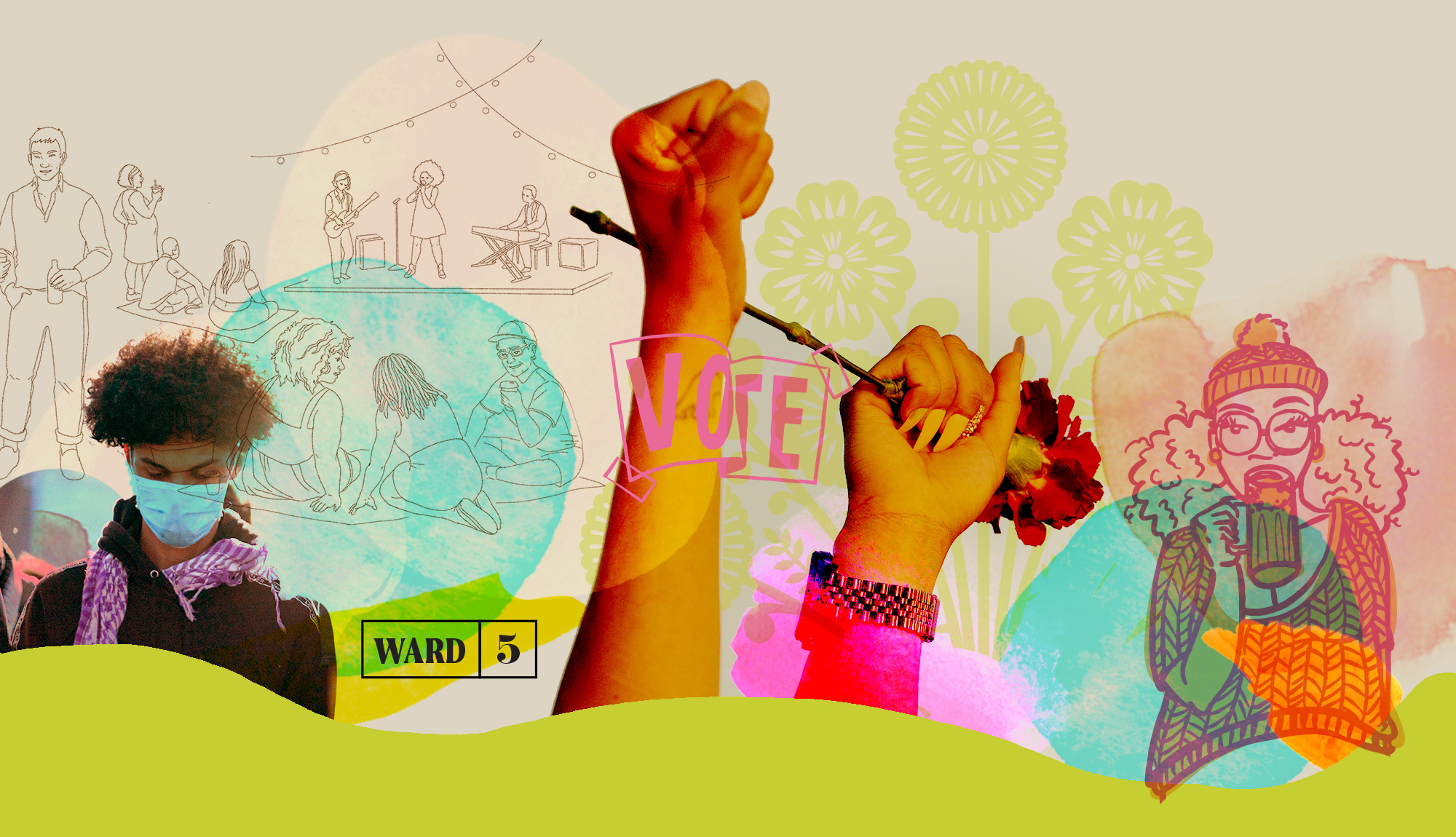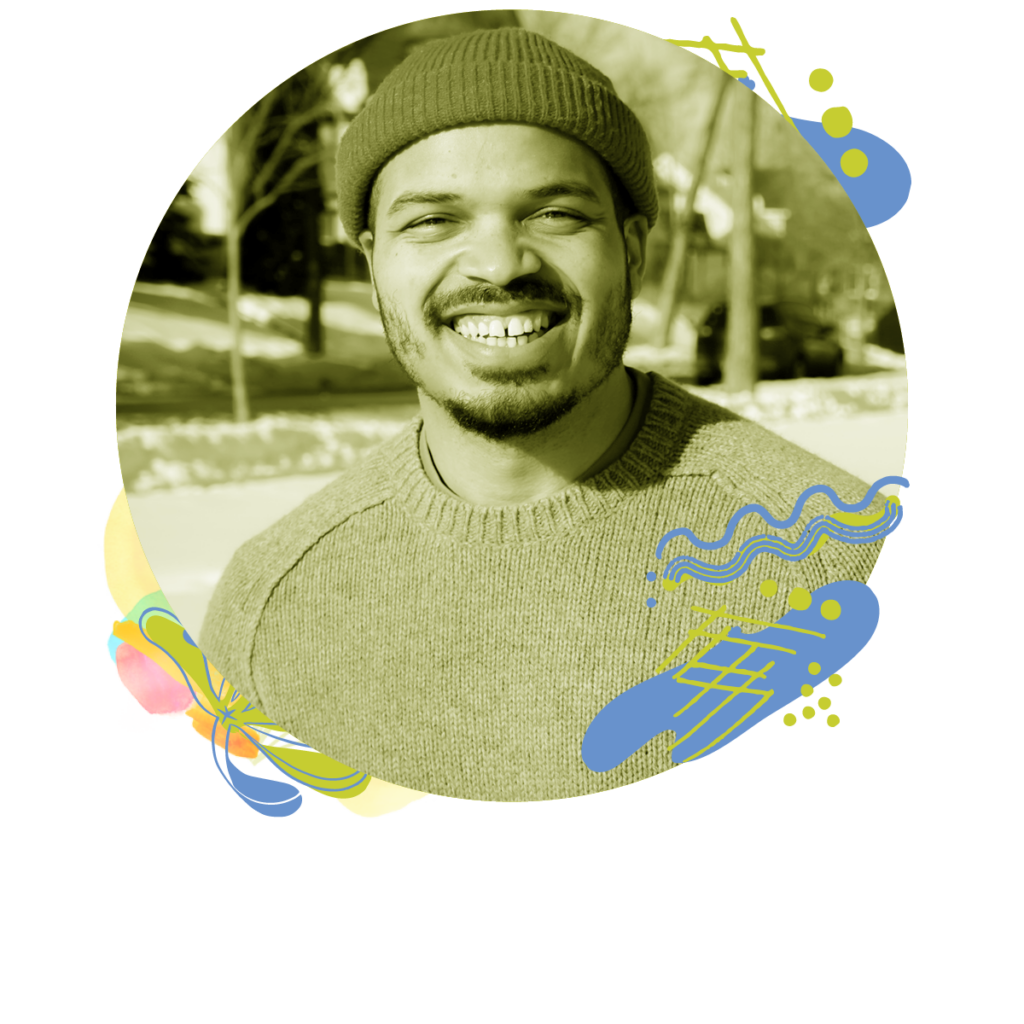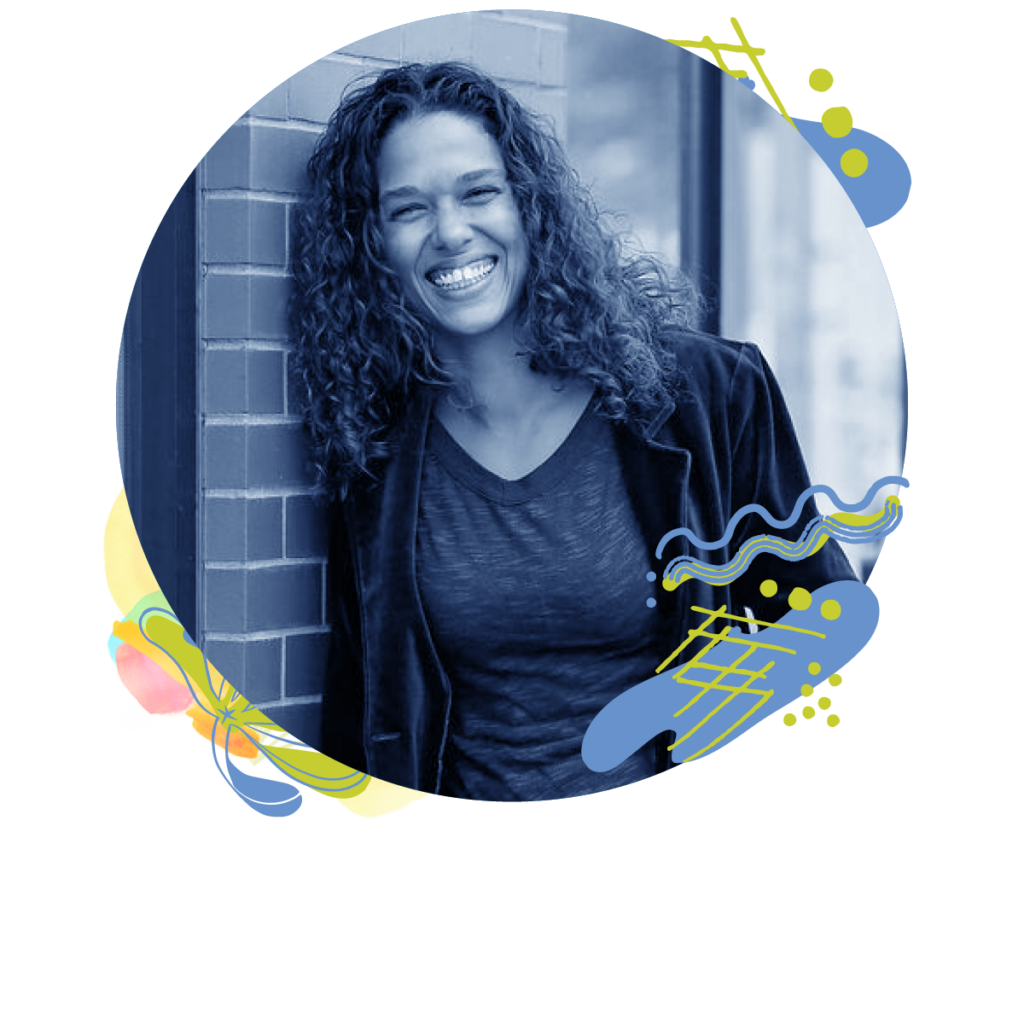



Victor Martinez
Did Not Respond

Suleiman Isse
Did Not Respond

Elijah Norris-Holliday
Did Not Respond

Cathy Spann
Did Not Respond

Jeremiah Ellison
Pronouns he/him/his
Party Affiliation Democratic Farmer-Labor
Website jeremiahforward5.com
Values
Communities can learn a lot about candidates from the ways they show up in their city and neighborhoods when the attention isn’t on them. What is one non-performative action you’re proud of that you’ve taken in support of the citizens you represent (or hope to represent)?
In 2018, I inherited the final stretch of the City’s five-year battle with an infamous landlord, Mahmood Khan. Khan had provided deeply substandard housing to some of the Northside’s most vulnerable residents, and used their imperfect eviction or criminal records, and poor credit scores to drive up rents with little to no improvements to their housing. While Khan alone carries the blame for providing such substandard housing, the City’s actions to hold him accountable were slated to result in the massive displacement of the very tenants they were hoping to help. In addition to a rigorous rehousing effort, and supporting a small group of tenants in buying their homes from Khan, I worked with City staff in CPED to create the Emergency Stabilization Pilot program. The program saw the City purchase 10 units where we currently house folks who faced displacement due, in part, to the City taking adverse action against their previous landlords. The intention is to transition ownership of these homes into the hands of the displaced tenants. This work also led to the creation of the Renter First policy, which seeks to center the needs of renters and prevent their displacement as we hold recalcitrant landlords accountable.
Public Safety
How will you keep young Black and brown kids safe — those who are simultaneously the most at risk from gun violence but also most at risk during interactions with the police? What do you believe are best practices for solving these issues in tandem, and how will you involve the communities most affected in problem solving and determining next steps?
My top priority as a public servant and neighbor is to see that my community make it home safe at the end of the day. This starts with focusing on peoples’ needs–like housing and employment stability–but there are also the day-to-day emergencies that must be addressed, and we have an obligation to ensure that that system works for everyone.
We need a system of emergency response that understands what kinds of emergencies the police are the best response to, and what emergencies need a new type of response–one that goes beyond the police-only model that produced George Floyd, Jamar Clark, Terence Franklin, and the list goes on.
We need to define the scope of the police, a scope that has broadened by the decade, to the point that nearly every 911 call that isn’t a fire or physical medical emergency gets a police response whether the situation truly calls for it or not.
The public health approach of the Office of Violence Prevention needs more investment–the aim is to target and treat cycles of violence before they get fully started.
Delegating traffic enforcement, homelessness response, and mental health emergencies to services more equipped to de-escalate, mitigate harm and create safety is a simple, easy, and necessary start to keeping people safe in our communities.
Those most affected by violence deserve to be at the helm of those conversations. There won’t always be agreement, but people should be given access to the truth and not fear-mongered into not asking hard questions or imagining a more just world.
People of color in Minneapolis are killed or otherwise harmed by law enforcement at disproportionately high rates, despite many attempts at reform over several election cycles. How do you intend to reshape a policing system that has been resistant to change, and slow to show meaningful strides toward equitable community outcomes?
I believe we need a complete rethinking of how we keep each other safe in Minneapolis–this means replacing MPD with a new Department of Public Safety, one that decenters police as the sole means of creating a safe community, and incorporates other forms of emergency response into its model of public safety. Our modern reform discussion has its roots in the 1919 race massacres in Chicago–known as Red Summer–and hasn’t really advanced in the subsequent 100+ years.
Often, going beyond the police-only model has been done in small bursts. We’ve seen Violence Prevention style programs be as or more effective in reducing violence in communities, only for them to disappear once violence goes down. These initiatives should grow, and they should become a regular part of how we keep people safe.
We should be reducing the role that police play in punitively regulating behavior that is generally nonviolent (such as chemical dependency, to give one example) and requires a different approach to actually solve the problem being faced.
What are your stances on memorializing public spaces when our community is grieving, and/or demanding action through constitutionally-protected protests? What policies would you put in place or what organizations would you engage to ensure residents can do these things safely?
I believe communities should be allowed to lead when it comes to memorializing spaces.
Protocols for conversation/negotiation with communities seem long overdue. When a tragedy strikes an entire neighborhood (or the entire city), residents deserve to be engaged in good faith, not just when there is fearful of backlash or outrage. Residents that do show outrage should have a platform, and not be treated with hostility or annoyance from the City.
Housing
Rental assistance from the federal government has helped keep people in their homes through the pandemic. This funding is not permanent, however, and inability to pay is the leading cause of evictions. What is your stance on more permanent rental assistance, rent stabilization, and/or rent control measures in Minneapolis?
Tenant rights have been the defining pillar of my first term in office, and I will continue to advocate for and fight for the dignity and stability of renters.
I am proud to have co-authored the two Rent Stabilization charter amendments. I’m very happy to see at least one of them advance to voters this November–I urge everyone to vote “yes” on Rent Stabilization. In my first year in office, I was told this policy was an impossibility in Minneapolis, that the state law was too high a bar to clear and that the political will did not exist. We are proving that the residents of Minneapolis are more than willing to clear the state’s bar, and with the passage of this charter amendment, we will finally be able to draft and pass a substantive Rent Stabilization ordinance.
Gentrification results in cultural loss for communities and major economic impacts for those priced out of their longtime neighborhoods. As our city grows, what plans do you have to combat gentrification and increase the amount of affordable housing available in Minneapolis?
My colleagues and I have already surpassed the previous rate at which affordable housing is being built in our city, but it’s not enough, there is still a ton more work to be done.
I created the Renter First policy–which centers the dignity of renters in the inspections process. Previously, city action against recalcitrant landlords has often resulted in the displacement of the very tenants the City has hoped to serve. The Renter First policy changed that, delopying legal tools at the City’s disposal to prevent tenants from being displaced as we hold their landlords accountable.
I researched and championed the City’s “right to return” preference policy, which will give preference for homeownership and rental properties to people displaced from the neighborhood for a list of defined circumstances.
I co-authored the City’s Renter Protection ordinances, which expand access to renters through the regulation of screening criteria and by capping security deposits.
I created the Emergency Stabilization pilot program as a way to field test the best ways for the City to ensure housing stability and potentially expand and promote access to homeownership.
Most recently, in addition to co-authoring the Rent Stabilization charter amendments, I’m co-authoring the city’s Tenant Opportunity to Purchase ordinance, which will give tenants the first right to buy the property they live in when their landlord goes to sale it.
In the last few years, Minneapolis has experienced a spike in encampments of unhoused people on public land — a high percentage of whom are Black and/or Indigenous. Many of our unhoused neighbors see this as their best housing option over shelters (for reasons of personal safety, pet ownership, or having to abandon property). What will you do to protect these neighbors and connect them with safe and stable housing?
I am seeking to center the agency and safety of encampment residents in my approach. Encampments can be incredibly difficult situations. Self sufficiency is often not valued by local governments; determined encampment populations are essentially punished by a lack of engagement from local governments; lack of engagement often leads to abuse within the encampment. It’s a predictable cycle that we can prevent by building more lower barrier shelters and increasing rental assistance and employment accessibility. Other things, like the creation of safe injection sites and cluster developments, will also be important steps for us to take in addressing this crisis.
Jobs and Economy
Black, Indigenous, and Minneapolis residents of color pay local taxes and contribute to our local economy, but often do not receive the same shared economic benefits as their white counterparts. Through generations of oppression via policy and unequal systems, wealth has been chronically and systematically extracted from BIPOC communities—how do you envision addressing this legacy of economic harm, in both the short term and the long term?
During my first term, undoing this legacy of economic harm was a top priority, in addition to addressing many housing needs, I sought to open up opportunities for wealth building beyond homeownership. I worked to create and champion the Commercial Property Development Fund (CPDF). The CPDF seeks to increase local and PoC commercial property ownership, and it’s working. Since the creation of the fund, I have seen several Northside business owners buy buildings that wouldn’t have been within reach if not for the CPDF.
I have fought for funding for various jobs training organizations, especially Renewable Energy Partners, a jobs training facility and program aimed at getting black, indeginous and all communities of color into the ever growing green energy fields. Solar array and rain garden installations are just a few of the skills they train on, which has the added benefit of helping us preserve our planet as we strengthen professional opportunities for neighborhoods that have historically been denied access to that.
The power dynamics of work are heavily tilted against low-wage workers, especially immigrant workers. What actions have you taken or what plans do you have to protect and support these workers?
Protecting low-wage workers, and wage earners in general, requires hypervigilance, especially as many companies and corporations seek to exploit the pandemic in order to force more work for lower pay and even lower hours and less benefits.
I have fought for and supported the City’s Wage Theft ordinance to protect workers against Wage Theft.
I have worked to maintain the City’s labor standards to prevent labor trafficking and promote union jobs.
I supported the City’s Right to Recall ordinance, supporting many workers in getting their jobs back as businesses have begun to reopen during our ongoing pandemic.
I supported the Adult Entertainment Ordinance to better protect sex workers from workplace expoitation, and support further strengthening our enforcement of this work.
Racial Justice
Explain your understanding of systemic racism, and how—or whether—you believe it affects Minneapolis’s education systems & outcomes, our housing market, our environment, public safety, healthcare, or other major systems.
Systemic racism is about institutions that produce consistently racist outcomes, regardless of the intentions of the people who run or function within that institution.
I believe that the City of Minneapolis is such an institution, it was one of my primary motivations for running, and it’s why I want to go back to City Hall to both continue and finish the work I’ve started to undo the functions of our institution that consistently produce poor outcomes for black and brown people.
Our community suffers from some of the greatest racial disparities in the country across many social, educational, and economic metrics—and has for some time. If you’re in government now, what have you done to address this, and do you feel your efforts have been enough despite the lack of change? And if you’re seeking office for the first time, what ideas are you going to put forward that haven’t already failed?
I know that the Commercial Property Development Fund has already, in just 2 years of existence, increased black and brown ownership of buildings along corridors like Lake St and W Broadway, and I believe that we can begin to make real systemic shifts if we increase opportunities the ones this fund creates. But no, as it stands, there is more work to be done.
I know that Tenant Protections, the Renter First Policy, Relocation Assistance, and the Emergency Repair Board have kept vulnerable tenants housed, increased the dignity of the housing of many renters across the city, protected people from frigid temperatures in the winter and blistering heat in the summer. And I believe that Rent Stabilization, Tenant Opportunity to Purchase and more affordable housing will create real systemic shifts if passed. But no, as it stands, there is still much more work to be done.
And I know that people having more money in their pockets, and more security in their job, and more security in their housing will create a more just condition in our city. I believe my work has had an impact, and I believe I have so much more to do, and so much energy to get it done.
Climate
Climate change is already upon us, and its causes are on such a large scale that we can’t expect everyday Minneapolitans to recycle or LED bulb our way to a solution. How would you encourage businesses in our city to adopt practices to mitigate climate change, and/or hold them accountable for practices that worsen it?
We need to also invest in local urban agriculture which increases access to fresh, healthy produce for our communities, supports our pollinators, and decreases the reliance on co2 heavy shipping of produce to our city. Local organizations such as Appetite for Change, Green Garden Bakery, Youth Farm, and Spark-Y have been leading the way and should be supported by city resources and infrastructure.
I believe moving towards a 100% renewable-energy economy starts with our own City infrastructure, and the investments we make and facilitate out in our communities. Helping to fund solar and rain gardens are a good start, transitioning City vehicles to 100% electric is a great goal to set, but I also believe we need to increase our investments and transition these ideas and programs out of the “niche” or pilot phases they are often relegated to. I plan to continue voting to make these investments, to support green jobs training programs in my ward—like the one on Plymouth Ave, Renewable Energy Partners—and to strengthen energy efficiency standards in new construction.
We need to lead the way with green energy solutions which both support our local economy and reduce our carbon footprint. That means investing in solar energy across the city, green roofs and moving away from superfluous short trimmed lawns in public spaces which demand an incredible amount of water while their short root systems do little for and often contribute to our increasingly fragile ecosystems.
Voters’ Rights
What have you done or what will you do to protect and expand voter access in your ward/Minneapolis?
In my campaign, we focus on increasing voter participation on the Northside. We added hundreds of new voters to the 2017 electorate and will continue to strive to do the same this year. This includes talking to people who typically don’t vote in these local races, finding unique ways to engage and meet people where they are, and, when necessary, giving folks rides to their polling places or the early voting center.
As the chair of the Elections Committee before the council’s restructure (due to COVID), I fought for additional early voting locations and voter education guides.
Governance
Who are the people and/or organizations that would be part of your decision-making process in office?
First and foremost, I work for the people of North Minneapolis. I will continue to center Northside voices in all that I fight for. Any and all organizations that I partner with or seek advice from must take their commitment to propping up the voices of the Northside as seriously as I do. This means going beyond the simply northside-gatekeeper class, and building connections with everyday people.
I believe tenant lead advocacy groups (like Inquilinxs Unidxs, for example) need to be heard in housing policy discussions. I believe small business groups (like NEON, WBC, and Main Street Alliance, to name a few) need to be heard as we try to strengthen our small business community. And I believe it’s going to take every voice in the city (including our Black Faith community, our strong activist community, and those most affected by our current police-only model).
Last Word
What’s one thing you think Minneapolis does well that you’d like to build upon if elected?
I think the City of Minneapolis is very good at pushing the boundaries of the traditional role of local government. Despite a tough year+ (felt by every state and major city in the US) we remain a national leader on how to address the affordable housing crisis, how to undo racist zoning and land-use policies, and how to expand public safety beyond the police-only approach. I believe we have an opportunity to really lead on issues like addressing gun violence, homeless encampments, police brutality, and closing the homeownership gap. And when we allow our decisions to be driven by our hopes and not our fears, as Nelson Mandela once put it, our city will be a safer and more just place for everyone, not an oasis for the white and privileged.

Kristel Porter
Pronouns She/Her/Hers/They/Them/Theirs
Party Affiliation Democratic Farmer-Labor
Website northsidersforkristel.org
Values
Communities can learn a lot about candidates from the ways they show up in their city and neighborhoods when the attention isn’t on them. What is one non-performative action you’re proud of that you’ve taken in support of the citizens you represent (or hope to represent)?
Having to leave my home at the age of 14 while raising children alone, housing was a constant struggle. Accessing it, and sustaining it was a constant rat race. Having to start over twenty-one times. Overcoming that experience, I made my goal to one day provide housing for others struggling through that same experience. As soon as I completed my college degree, I repaired my credit and bought a duplex right before the housing market began to skyrocket. During my free time, I have been able to help 7 families transition from shelters (3 are now homeowners in North Minneapolis). I am working to purchase another property to continue to keep rent affordable in a community that has the lowest AMI, yet working to make sure that these families have the same opportunity I had; building wealth through property ownership. In a city where white families own their homes at a rate 4 times than that of black families; true change will not happen until we work like hell to change that narrative.
Public Safety
How will you keep young Black and brown kids safe — those who are simultaneously the most at risk from gun violence but also most at risk during interactions with the police? What do you believe are best practices for solving these issues in tandem, and how will you involve the communities most affected in problem solving and determining next steps?
In order to make sure that children are safe we have to first make sure they have their basic needs met; shelter, food, love, etc. So first, I would advocate that MPRB, MPS, and all organizations that provide programming, meals and activities to children be expected to work together. No more silos. MPRB & MPS should be working hand in hand. When schools are out (whether it be evenings, weekends, holidays or summer), the parks are in. MPS staff should be allowed to bid on jobs available at our parks and offer stipends for coaching. Not every park has a Recreational Facility, but every park has children. We need to staff these parks so that children can have mentors that they recognize from their schools and can grab a lunch provided by the MPS food truck. Creating partnerships gives community members a 1 stop-shop to find out where and when there is programming for their children so that they don’t have to call around for hours. It also helps organizations get the word out when their programming budgets are already limited.
The real way to address gun violence is something that is outside the authority of the city council and would take for our state and federal legislatures to regulate online ammunition purchases. However, as a city council representative and the relationships I have developed with state legislators, I will work to advocate for that since Ward 5 residents have a higher than average rate of gun violence. When purchasing a gun online, you have to show up to a local store to pick it up. However, many guns that are in the hands of those who are committing violent acts, have purchased their guns illegally or were able to access their guns illegally by theft. When they want to buy ammunition online, they can order a box and have them sent directly to their home. No need to provide Identification, no need for a permit, just the money needed to purchase. (https://www.americanprogress.org/issues/guns-crime/reports/2019/10/07/475538/bullet-control/)
People of color in Minneapolis are killed or otherwise harmed by law enforcement at disproportionately high rates, despite many attempts at reform over several election cycles. How do you intend to reshape a policing system that has been resistant to change, and slow to show meaningful strides toward equitable community outcomes?
I am someone who has always believed that the Minneapolis Police Department was in desperate need of reform. The Federation that represents Minneapolis Police Officers has been representing and saving officers jobs, who have been repeatedly abusing their authority for years through a process called “arbitration” which has been operating off of precedence since 1972 when the Police Officers Federation earned collective bargaining rights and became a fully recognized union. Fifty percent of officers that go through arbitration, get their job back because of precedence (letting one person get away with someone because someone else did before). So I would support that the Minneapolis Police Department have written in their contract that any officer that is fired because of using force or or found to be dishonest on a police report, is not allowed to go through the arbitration process. They will not be allowed to serve as an officer in our city. Also, a common sense approach to making this possible would be to require officers to carry liability insurance (since most high risk professions do). This way if they are uninsurable, they cannot serve as an officer in our city. I also oppose the fact that our lieutenants and inspectors, (ie supervisors) are represented by, and share the same union as their subordinates (those who are supervised). It is a major conflict of interest and only allows corruption at the top since all members do not want their bargaining powers to be compromised by disciplining another member (smh). I would also like to highlight the fact that officers do not abide by the requirement that they are to take 12 hours off in between shifts in order to rest and manage their mental health. “Off Duty Work,” which pays them a lot more than “On Duty” is not counted as work within those 12 hours (hmmm).
[Editorial Note: The original response exceeded our word count limit. Only the first 300 words are published here.]
What are your stances on memorializing public spaces when our community is grieving, and/or demanding action through constitutionally-protected protests? What policies would you put in place or what organizations would you engage to ensure residents can do these things safely?
Allowing people the right to protest and memorialize when they have lost a loved one is essential to the process of healing, and should always be the right of anyone and everyone. Anything less would be undemocratic.
The only time that government should interfere, is when the space is posing a proven health or safety risk to the community and in that case, it would be the responsibility our elected representatives to sit down with the community and allow them to lead their representative to an agreeable solution to memorialize fairly.
Housing
Rental assistance from the federal government has helped keep people in their homes through the pandemic. This funding is not permanent, however, and inability to pay is the leading cause of evictions. What is your stance on more permanent rental assistance, rent stabilization, and/or rent control measures in Minneapolis?
This is a very complex question with layers so I will answer each one separately:
The moratorium has been great for the renters who are able to get access to it or are civically engaged enough to know it exists. The most recent one (Zero Balance Project) has been even more beneficial because the landlords can take matters into their own hands and apply yet must wait on the renters to approve the online application. I know of landlords that have been waiting months for their tenants to go into their emails and approve for the funding to be released so their landlords mortgage and water bills can be paid. This is a major problem. I support the moratorium, and we need figure out a way to help the renters get the funding needed to the landowner, so that the landowner does not risk defaulting and losing the home that they are providing for rent.
If we want to make rental assistance permanent, this will need to come from federal funds which will be allocated by our state legislature, and decided on by our County Commissioners. Unless we are willing to create a TIF district to provide funding for rent assistance programs, energy efficiency and renewable energy updates and upgrades for blighted communities through our State Legislature, which I would be in full support of. When it comes to the issue of Rent Control will not work without TOPA. We have to address that one right away. Once again, I represent North Minneapolis where the rent only increases between 1-1.5% annually and where we have the lowest rents in the city. I have three friends in North Minneapolis who are Black and who own single family homes that they rent out. 2 out of 3 have put their homes up for sale because of the proposed Rent Control and 1 of them turned their home into a Air BNB.
[Editorial Note: The original response exceeded our word count limit. Only the first 300 words are published here.]
Gentrification results in cultural loss for communities and major economic impacts for those priced out of their longtime neighborhoods. As our city grows, what plans do you have to combat gentrification and increase the amount of affordable housing available in Minneapolis?
The city needs to start getting a little more creative on this one.
We could start by allowing the construction of tiny homes and allowing more creative ways to ease the financial burden of those who want to build wealth through land ownership. The housing market is ridiculous right now. Just a decade ago, I could purchase a home in my community for $10k, now you can’t find anything under $200k. The quickest way to creating generational wealth is through landownership, so we cannot afford to continue placing affordable rentals as a higher priority than affordable ownership models.
As I stated in the previous question, the city needs to start identifying vacant, boarded and abandoned properties. Then develop a partnership with a mix of neighborhood led Community Development Corporations, local developers, and residents to creatively place-make and develop high quality residential spaces that are desired and needed for that particular neighborhood.
Yet the only way we will be able to accomplish this, is for our representatives, local developers, community driven realtors, and lenders, to get more creative on financing affordable housing. Three years, it way too long and way to complicated to organize all the hoops and hurdles needed to fund affordable housing projects. It makes many not want to do it, and leaves us with very few developers with big enough hearts to weather the storm.
We need to be serious about prioritizing Tax Increment Financing to develop affordable ownership and rentals on residentially zoned properties. Yet we also need to be mindful about not building 100% residential and instead building mix-use residential on our commercially zoned corridors. 100% residential on commercially zoned properties, robs us of a major tax base which holds back the future funding needed to ensure the sustainability of our schools, parks, roads, and other public spaces.
Also, we need to be mindful of how our community is changing along with its needs.
[Editorial Note: The original response exceeded our word count limit. Only the first 300 words are published here.]
In the last few years, Minneapolis has experienced a spike in encampments of unhoused people on public land — a high percentage of whom are Black and/or Indigenous. Many of our unhoused neighbors see this as their best housing option over shelters (for reasons of personal safety, pet ownership, or having to abandon property). What will you do to protect these neighbors and connect them with safe and stable housing?
Our government massively pulled funding out of Mental Health in 1981 when President Reagan repealed Carter’s legislation with the Omnibus Budget Reconciliation Act. This pushed the responsibility of patients dealing with mental health issues back to the states. That legislation created block grants for the states, but federal spending on mental illness declined drastically, now fast forward to today the U.S. Department of Justice estimates that 10 percent of state prisoners have symptoms that meet criteria for a psychotic disorder and 55 percent of people experiencing chronic homelessness report they have emotional or psychiatric conditions.
Why are the most vulnerable populations not receiving preventative care, therapy, medication and housing immediately while they are transitioning out of the public school system? They needed housing, three square meals daily, therapy, medication, and public workers to spend time with them and love on them, immediately. Why are we waiting to react when these vulnerable and precious neighbors reach adulthood and have already spent years in and out of jail, self-medicating, committing crimes and becoming victims of crime?
In order to move forward and to address adults currently living in encampments today; I support building tiny home villages that are maintained and managed by social workers, case workers, nurses, and contracted by locally owned property maintenance companies. In order to address our youth and very young adults living with mental illness and physical and mental disabilities; we need to create a robust strategy to properly and immediately meet their basic needs while exiting our public school system.
This will take time, yet in one short decade, we will begin to enjoy a sustainable model that will have a positive impact on our cities livability for generations to come.
Jobs and Economy
Black, Indigenous, and Minneapolis residents of color pay local taxes and contribute to our local economy, but often do not receive the same shared economic benefits as their white counterparts. Through generations of oppression via policy and unequal systems, wealth has been chronically and systematically extracted from BIPOC communities—how do you envision addressing this legacy of economic harm, in both the short term and the long term?
Economic improvement and stability has been, and continues to be a huge issue in BIPOC communities. Our city has a history of choosing to divest and deprive us of our power, rights, and land. The only way we will overcome this is by implementing policies to build a sustainable economy within our BIPOC communities. This will benefit everyone in our entire city for generations to come.
Currently, city planners and developers are saying we can’t attract businesses without a higher AMI (Area Median Income) and I say, we can’t increase our AMI without providing local living wage employment opportunities for our underserved, underrepresented, and under employed residents.
The only way we can address this issue without displacing our most vulnerable community members, is to first build up our local BIPOC owned businesses from within. After generations of racial covenants blocking black and indigenous communities to land equity and barricading the ability for BIPOC businesses to access permits, licensing and capital, the city owes us BIG.
We must provide real incentives to attract and support BIPOC entrepreneurs so they can start and maintain sustainable businesses. By doing this, we will increase employment for our BIPOC residents, capture the dollars that are leaving our community, and attract patrons from outside of our communities.
Yes, and we need someone in office who knows how to develop this model without displacing community members and fellow citizens.
I plan to create a 5 year program that will aid new and existing businesses that are located along blighted commercial corridors. This will ensure economic sustainability, and will preserve our community’s rich and vibrant culture by eliminating displacement. This program will include;
1. Grants to build-out business space
2. Employee wage subsidies to create living wage jobs
3. Marketing subsidies and support to boost patronage
4. Real business technical support while providing a temporary zero sales tax benefit
5. Capital investment and support for business owners to purchase commercial property
6. Incentives for businesses who choose to hire residents from within their zip code
The power dynamics of work are heavily tilted against low-wage workers, especially immigrant workers. What actions have you taken or what plans do you have to protect and support these workers?
I support $15 minimum wage, as well as sick and safe time for every employee.
Because the work of immigrant and low wage employees tend to have higher risk, their employers must be held accountable for labor law violations while employees have resources available to represent them.
In order to protect our workers, we need to make it mandatory that all employers in our city are required to review their employees annually and must share with their employees how to contact our city’s Labor Standards Enforcement Division upon hire and with every annual employee review.
We must also require that employers that have reopened, to welcome back employees whom they have had to lay off due to temporarily closing their doors or decreasing capacity due to an event outside their control such as a natural disaster, pandemic, damages to property, etc.
Racial Justice
Explain your understanding of systemic racism, and how—or whether—you believe it affects Minneapolis’s education systems & outcomes, our housing market, our environment, public safety, healthcare, or other major systems.
Through our city’s history of redlining through racial covenants and blocking our BIPOC business owners from public funding, proper licenses and permits, we have been left out of the opportunity of land ownership, building equity, qualifying for business financing and creating jobs. This has led to a weak tax base and ultimately a decrease in funding for our public spaces such as schools, programming in our parks, and the maintenance of our roads and walkways.
After serving as an ESP Union Steward, working for the Minneapolis Public Schools in Special Education and sitting on various public school Site Councils in North Minneapolis, I will say that there hasn’t been a year that has gone by where parents, faculty, staff, and students are presented with the question of: “what are you willing to let go, what teacher or services are you willing to lose?” Every year our government pulls funding from our public education and the schools who are hit the hardest are the ones that have the highest enrollment of BIPOC students.
After coaching in our public parks for over 16 years, I have felt the impacts by not having the necessary tools and equipment to provide programming and oftentimes having to come out of my own pocket to provide these things while volunteering to be their coach.
Being a lifelong environmentalist in North Minneapolis, I have seen how our city has had a history of allowing an over concentration of factories that have been harmful to our health. Causing our communities to have the highest rates of asthma and cancer in our state.
Our city has a history of over-concentrating housing for ex-offenders, residents in transition and residents in treatment; within our BIPOC communities. This has also led to an increase of crime, making us vulnerable to be victims of crime, and overburdening our public schools that serve our BIPOC children. This has led to low test scores, high dropout rates, and higher rates of recidivism among BIPOC residents.
Our community suffers from some of the greatest racial disparities in the country across many social, educational, and economic metrics—and has for some time. If you’re in government now, what have you done to address this, and do you feel your efforts have been enough despite the lack of change? And if you’re seeking office for the first time, what ideas are you going to put forward that haven’t already failed?
I would advocate that MPRB, MPS, and all organizations that provide programming, meals and activities to children be expected to work together. No more silos. MPRB & MPS should be working hand in hand. When schools are out (whether it be evenings, weekends, holidays or summer), the parks are in. MPS staff should be allowed to bid on jobs available at our parks and offer stipends for coaching. Not every park has a Recreational Facility, but every park has children. We need to staff these parks so that children can have mentors that they recognize from their schools and can grab a lunch provided by the MPS food truck. Creating partnerships gives community members a 1 stop-shop to find out where and when there is programming for their children so that they don’t have to call around for hours. It also helps organizations get the word out when their programming budgets are already limited.
The real way to address gun violence is something that is outside the authority of the city council and would take for our state and federal legislatures to regulate online ammunition purchases. However, as a city council representative and the relationships I have developed with state legislators, I will work to advocate for that since Ward 5 residents have a higher than average rate of gun violence. Unfortunately due to the many instances of maltreatment towards certain community members by the Minneapolis Police Department, our city has been the spark that ignited different movements such as the more recent Black Lives Matter Movement all across the nation and the entire world. As a community, it is up to us to review the reasons why these issues seem to remain present in our department and find ways to make sure that all members of our community enjoy the right to feel safe.
Climate
Climate change is already upon us, and its causes are on such a large scale that we can’t expect everyday Minneapolitans to recycle or LED bulb our way to a solution. How would you encourage businesses in our city to adopt practices to mitigate climate change, and/or hold them accountable for practices that worsen it?
We were getting so close, then our last president took us on a time machine ride back to the 50’s. We had the environmental revolution we have all been waiting for in 2020, then a pandemic hit us, and we increased our purchasing of take out and our city stopped enforcing the ban on styrofoam containers.
I will work to require all restaurants to refrain from using styrofoam, to be required to provide biodegradable and compostable take out containers only and push our stores to eliminate providing plastic bags to customers. I will also push that all businesses participate in the Organics and Recycling Programs provided by the city.
I will work to offer incentives for restaurants and grocery stores that provide bulk purchasing through the use of re-usable and returnable containers and those that provide spaces for customers to recycle batteries, LED lightbulbs and other recyclable items that cannot be collected in their blue bins.
I will also work to provide incentives for businesses that choose to provide bike racks, and carsharing on their properties.
Voters’ Rights
What have you done or what will you do to protect and expand voter access in your ward/Minneapolis?
I have been volunteering to register members in my community to vote for over a decade.
Just last year, I volunteered for my neighborhood association to Get out The Vote (GOTV) at apartment buildings within my community, and knocked on hundreds of doors to remind people where, when and how to vote.
With my program Cycle Sisters, I partnered with Lyft, Nice Ride and Move Minneapolis to provide a “Roll to the Polls” event, which helped residents provided free Nice Ride, E-bike or scooter to get to their polling station to vote, while providing ride marshalls to show them the way and ride along with them.
When I worked as an employment counselor in North Minneapolis, I helped register my participants to vote, and helped many of them secure jobs as election judges and with organizations that conducted voter engagement.
Governance
Who are the people and/or organizations that would be part of your decision-making process in office?
First and foremost; my Minneapolis neighbors, friends, family, partners and co-workers (my tribe). DFL Environmental Caucus, MN350, Sierra Club, Senior DFL Caucus, Minneapolis Firefighters Union, Minnesota Nurses Association, West Broadway Area Business Coalition, all 70 neighborhood Associations, the Urban League, Minneapolis Public School students and employees, Minneapolis Parks staff and patrons, Black Nurses Association, NAACP, Communities Against Police Brutality, COPAL, Frayeo, Minneapolis Climate Action, MYDFL, Seeds to Harvest, the Black Firefighters group, local Northside developers, Local northside businesses that work to provide quality service and goods, A Mothers Love Initiative, Brothers Empowered, Faith groups, culturally focused organizations, Juxtaposition- any and all organizations that work to create a more safe, vibrant and healthy community for all.
Last Word
What’s one thing you think Minneapolis does well that you’d like to build upon if elected?
We are one of the strongest leaders in addressing our climate crisis. We can blow the rest of the country’s minds if we allow our amazing environmental groups and organizations to lead us to addressing this issue. They know what to do, and we need to trust them. Our climate crisis is the biggest issue of our time, despite what makes it to headline news. Do not be fooled. We have the human capital to get it right, and we just need to allow them to lead us out of this storm.
[Editorial Note: The original response exceeded our word count limit. Only the first 300 words are published here.]
